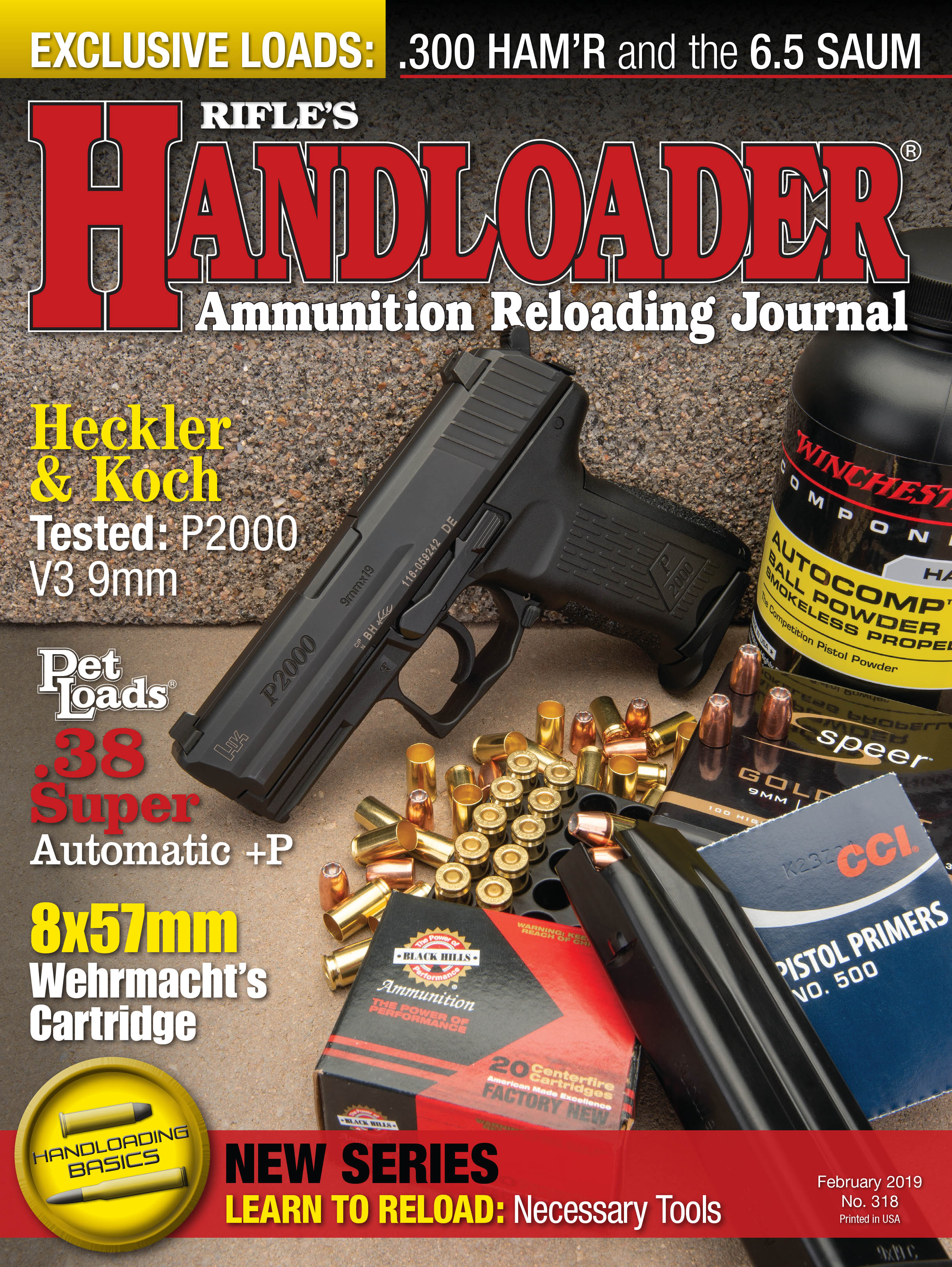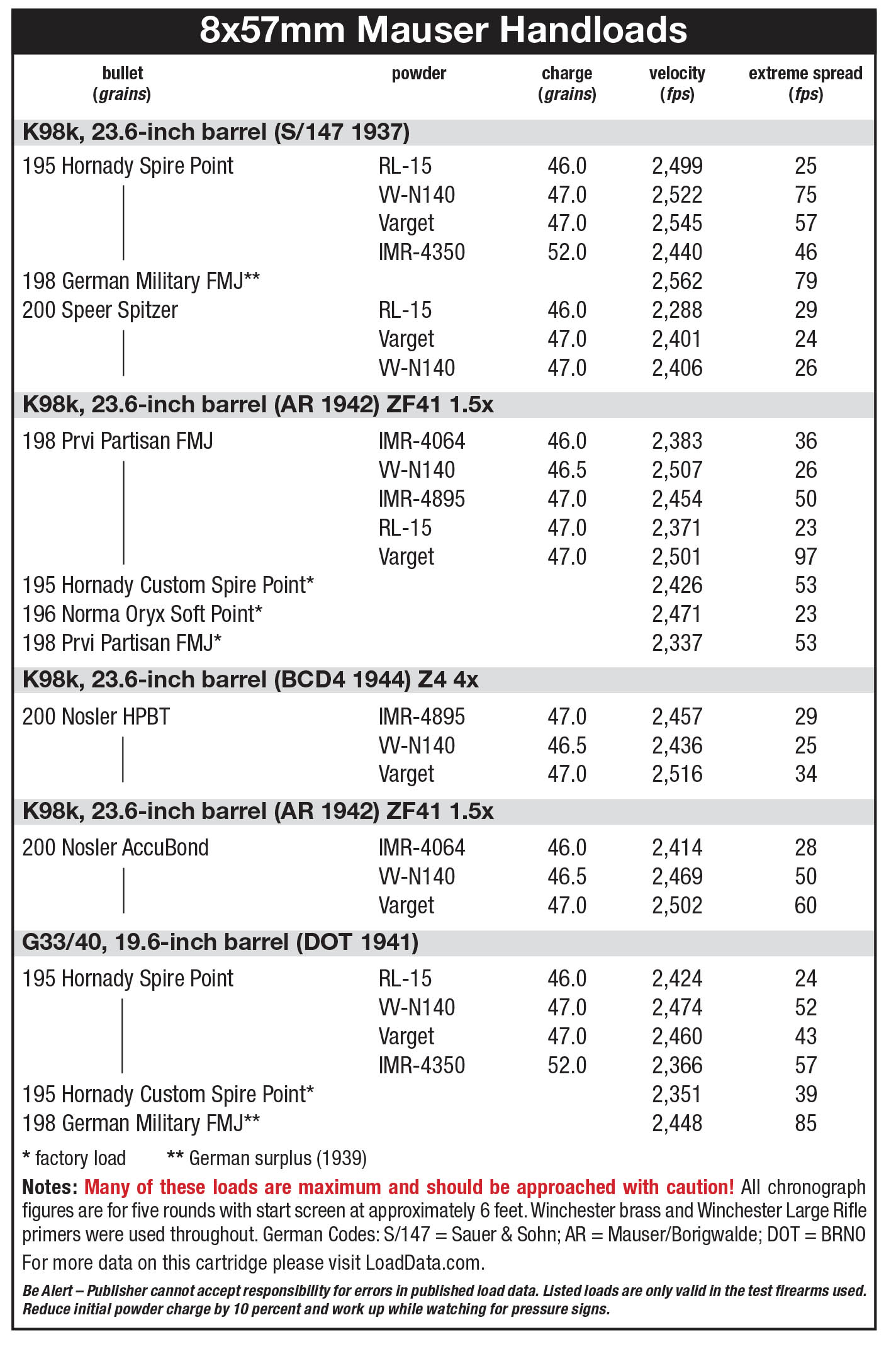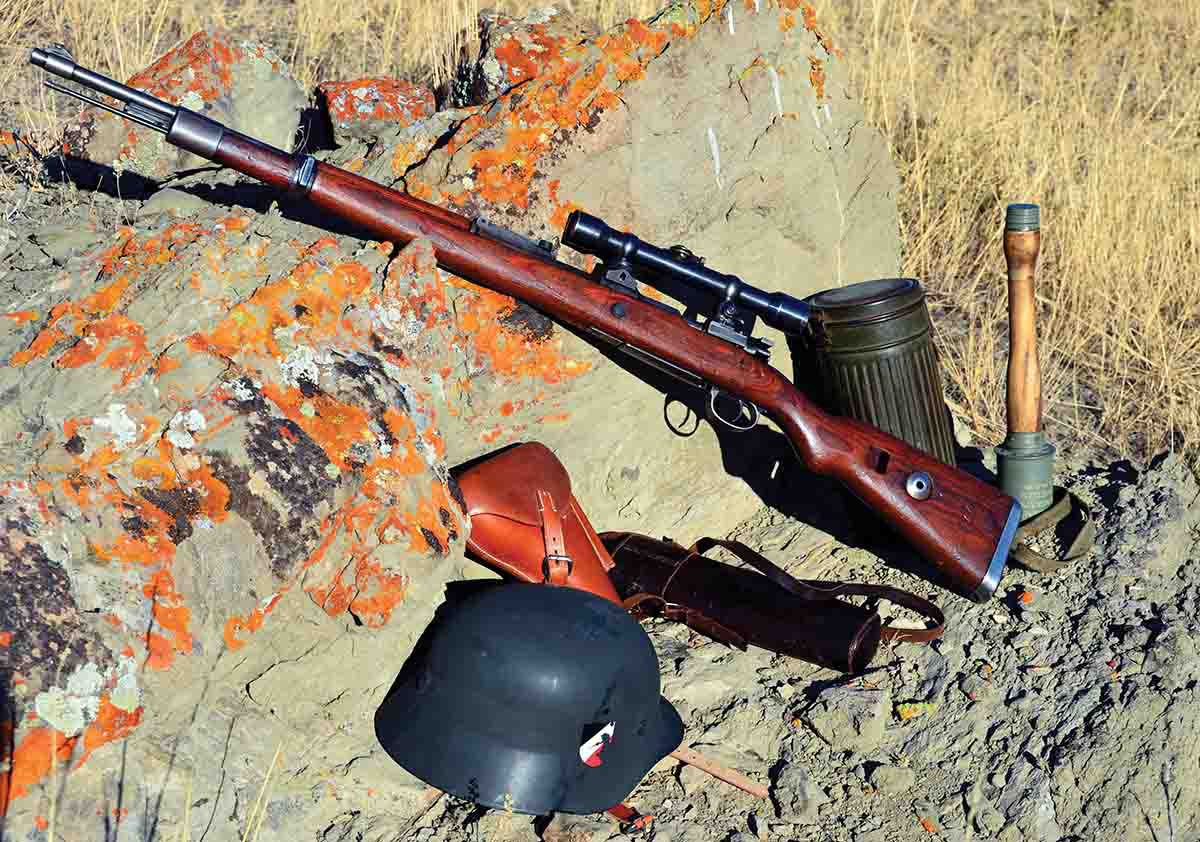
This K98k is equipped with a 4x scope in low turret mounts.
The 8mm Mauser was originally adopted by Germany’s army circa 1888, though it was never actually named “Mauser” by Germans; nor was it determined to be 8mm in bullet size. It was known to the Germans as the 7.9x57mm or 7.92x57mm. (American terminology will be used here because of its familiarity.) The cartridge served Germany continuously for 57 years until the end of World War II in 1945. However, the cartridge changed in regard to bullet size, weight and velocity.
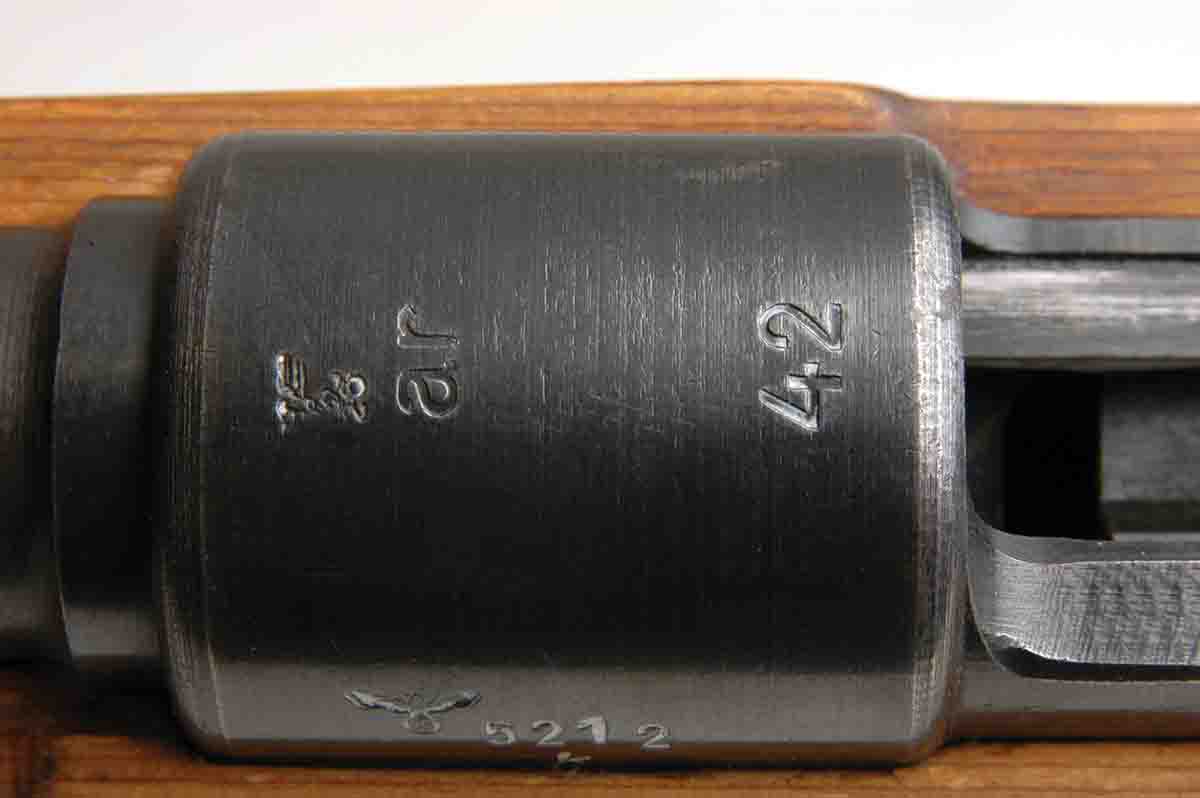
The Wehrmacht marked its K98ks with codes instead of each manufacturer’s name.
As introduced, this cartridge had a 226-grain roundnose, .318-inch bullet at about 2,100 fps with a case of new rimless design. Around 1905, bullet diameter was changed to .323 inch, weight was dropped to 154 grains, its shape was changed to spitzer and its velocity was increased to about 2,880 fps. If anyone doubts that the world’s major militaries kept a close eye on Germany’s developments, note that the U.S. switched to a rimless case design in 1903, and a spitzer bullet with a velocity of more than 2,700 fps in 1906. Of course, bullet diameter was .308 inch.
In the late 1920s and early 1930s Germany set about redesigning its military rifle from the Gewehr ’98, based on Mauser’s famous Model 1898 action. It had been the country’s front line infantry rifle in World War I and was used extensively in many conflicts and revolutions inside Germany during postwar unrest. In form, G98s had 29-inch barrels with a rather uniquely shaped open rear sight that collectors have termed “roller coaster.” Bolt handles were straight. Weight was nearly 10 pounds. In the interwar years the long G98 evolved into the K98, with the “K” standing for Karabiner, meaning carbine, or short rifle, in German.
Through many minor changes (denoted by letters of the alphabet as a suffix) the version with which the Wehrmacht finally equipped its front line units for World War II was the “k” version. Therefore, the proper term for it is K98k. Its barrel length was 23.6 inches, weight was reduced to 8.5 pounds, and the rear sight became a simple folding open-type ladder with a corresponding front blade dovetailed to a barrel stud. Bolt handles were then bent, and slings were moved from beneath to the rifle’s left side. With only minor changes as dictated by wartime emergencies, more than 10 million K98ks were built in Germany and other factories in conquered
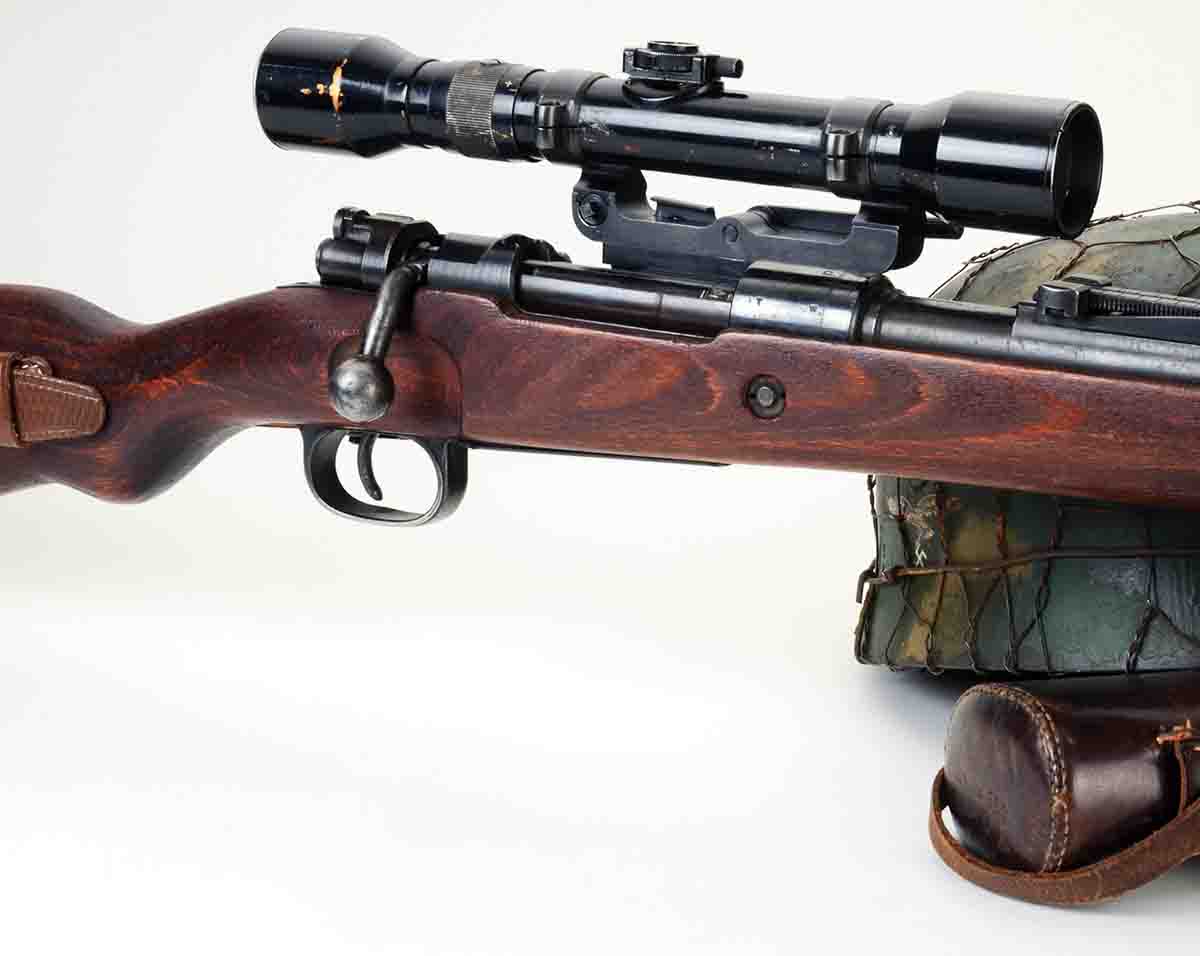
This 4x scope is mounted in long side rail mounts.
territories. Fabrique Nationale in Belgium and BRNO in Czechoslovakia come instantly to mind.
Along with the redesigned Mauser ’98, German ordnance officials also saw fit to change its cartridge somewhat. The bullet was still a spitzer but its weight was increased to 198 grains, and velocity was lowered to 2,540 fps. During the war many other loads were used, including vast stocks of ammunition captured from Poland and Czechoslovakia, nations that had also adopted the cartridge. However, Germany’s so-called standard was named s.S. Patrone as described above.
This seems like a good place to include 8x57mm specifications in American terms. The case uses the exact same .473-inch rimless head as the .30-06 using large rifle primers. Case length is 2.244 inches with a neck length of .319 inch, and an overall maximum cartridge length of 3.250 inches. In the U.S., the 8mm Mauser has often been ignored by ammunition factories. SAAMI’s specification for pressure is 35,000 psi. The reason is the J- and JS-bore size factor. As noted, original German specifications had a barrel groove diameter of .318 inch (J), which was changed to .323 inch (JS) circa 1905.
Therefore, fearing some of those very early .318-inch barrels made it to the U.S., pressures have been kept low. The K98k Mausers, if in good condition as determined by a qualified gunsmith, can easily handle higher pressures. European ammunition factories do not worry about the J and JS designations and load the round to its full potential.
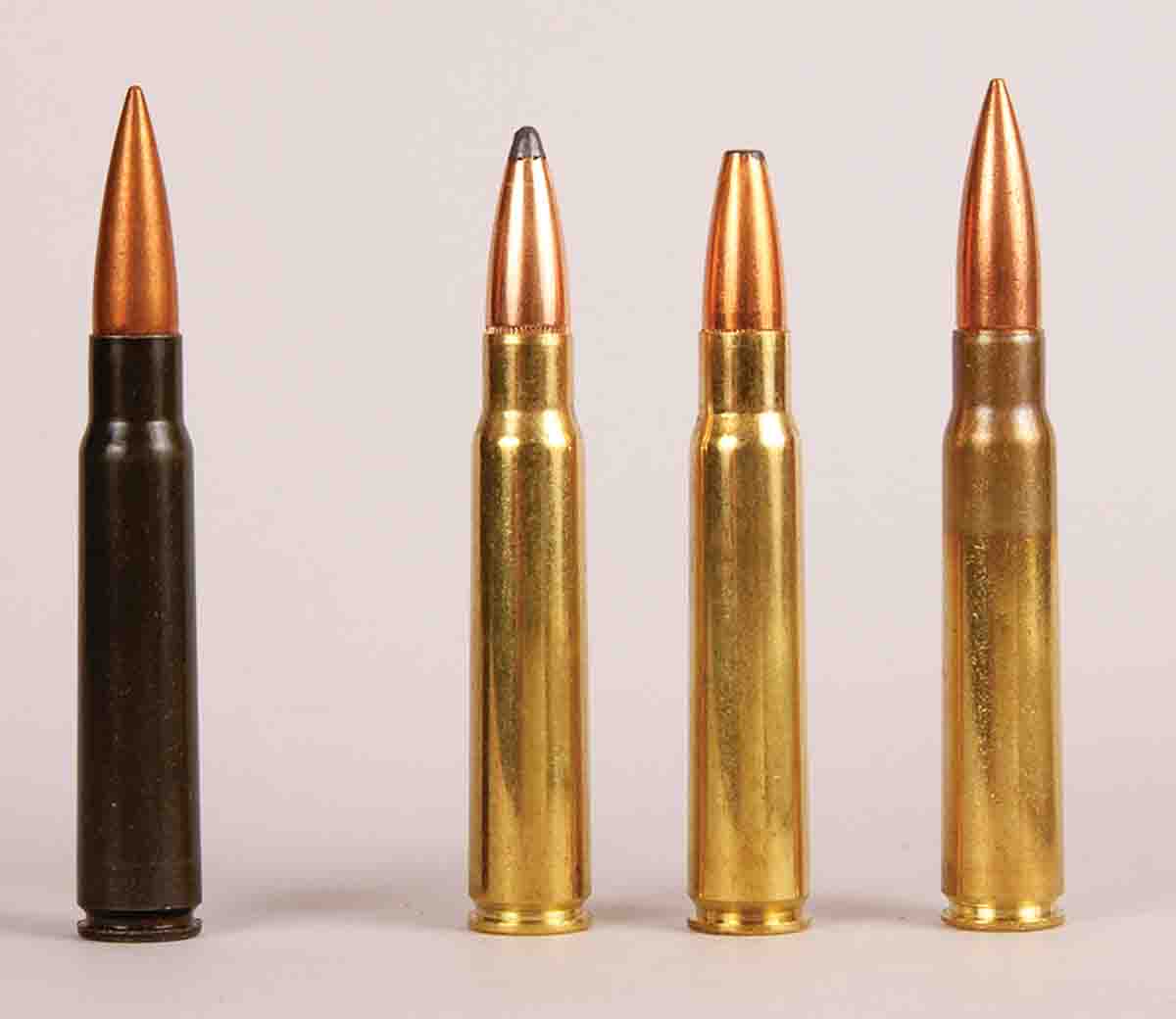
These cartridges include (left to right): an original German military round, a Hornady 195-grain Spire Point factory load, a Norma 196-grain softpoint factory load and a Mitchell’s Mausers 198-grain FMJ factory load.
There was another Wehrmacht ’98 Mauser 8x57mm that deserves attention. It was the BRNO-made G33/40. This was actually a carbine with a 19.6-inch barrel that some mixed-up German ordnance officer named “Gewehr,” which means rifle, while the standard K98k has a 23.6-inch barrel and is labeled Karabiner. It was built to be lightweight with cuts in the receiver and a hollow bolt handle. Even so, G33/40s received a sheet-steel plate on the rifle butt because these carbines were intended for Gebirgstruppen (mountain troops), and the steel protected the stocks when crossing ice. The G33/40 was produced to such exquisite quality that many of the 250,000 made have been torn apart just to use their light actions for high-dollar custom rifles.
At the beginning of World War II the Wehrmacht was not overly interested in infantry rifles. In fact, an upgrade from bolt actions to semiautomatic infantry rifles was happening in the U.S. with the M1, and the Soviets, with their SVT38 and SVT40, got only lackadaisical support in Germany. Despite some few thousand Walther and Mauser semiautomatics seeing action on the Russian front circa 1941, it was not until 1943 that a self-loader was put into full production. It was a Walther design with a 22-inch barrel initially named the G43, but later, with no changes in the rifle itself, it became the K43. Built in three factories inside Germany, definite production figures are not available. My best guess as to totals produced is between 400,000 and 500,000. Of course, chambering was 8x57mm.
Coming along late in the war, G/K43s did not get that famous German-production quality. Very little finish work was done, and Germany’s weapon metals became so inferior that small-parts breakage was common. One factory, the Berlin-Lubecker Machinenfabriken, even used a synthetic material called Durofol for its G/K43 handguards. Despite having a detachable 10-round box magazine, G/K43 doctrine required that they be loaded from the top with five-round stripper clips. By this time in World War II the Wehrmacht was toying with the idea that all infantry rifles should have telescopic sights, so G/K43s were built with an integral rail on the actions’ right side for that purpose. A small Z4 (4x) was developed for them. (As to the value of original Z4 scopes with mounts, I paid $1 more for mine than I paid
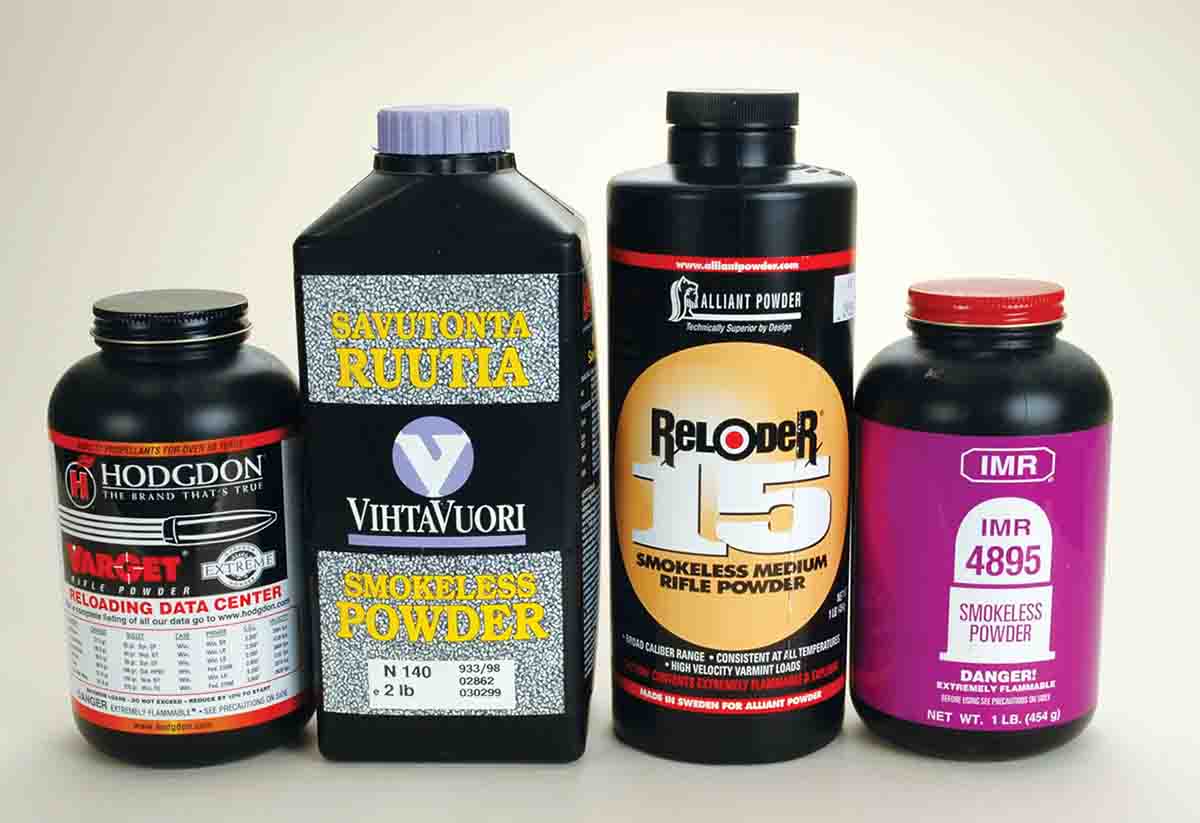
For duplicating World War II 8x57mm ballistics, these four powders seemed to work well.
for the rifle on which it was mounted.)
While on the subject of scopes, it should be mentioned that German ordnance officials were not overly concerned with sniper rifles early in the war, but eastern-front combat showed that the Russians definitely were. Excessive casualties among Wehrmacht officers and NCOs by Soviet snipers initiated a German counter-sniper program. This rush resulted in a mishmash of sniper rifles that can be extremely hard for today’s shooters to sort out. For instance, Germany fielded sniper rifles now known by collectors as low turret, high turret, short side rail, long side rail, swept-back and ZF41, just to name those I’m sure of.
Scope magnification ranged from 1.5x to 6x to the best of my knowledge and research. After much searching and a great deal of luck, I have managed to land low turret, short side rail, long side rail and ZF41 equipped K98ks – all more or less original. Although, counterfeiting has made determining authenticity difficult.
As a general rule, K98k sniper rifles were converted more or less one at a time. There was one exception. The factory Gustloff Werke, with code of BCD4, actually produced a K98k version destined for sniper use from the beginning. It had a 1⁄8-inch thicker left receiver rail that was machined flat and drilled for a long side rail scope mount. There had been difficulty with the curved short side rail bases loosening on the likewise curved left receiver rail of the standard K98k, hence the flat of the long side rail mount for mating with a flat surface on the receiver’s left rail. Also on this specific BCD4, only the steel buttplate was checkered. A few years ago I saw one of those checkered steel BCD4 buttplates on eBay priced at $990. It sold.
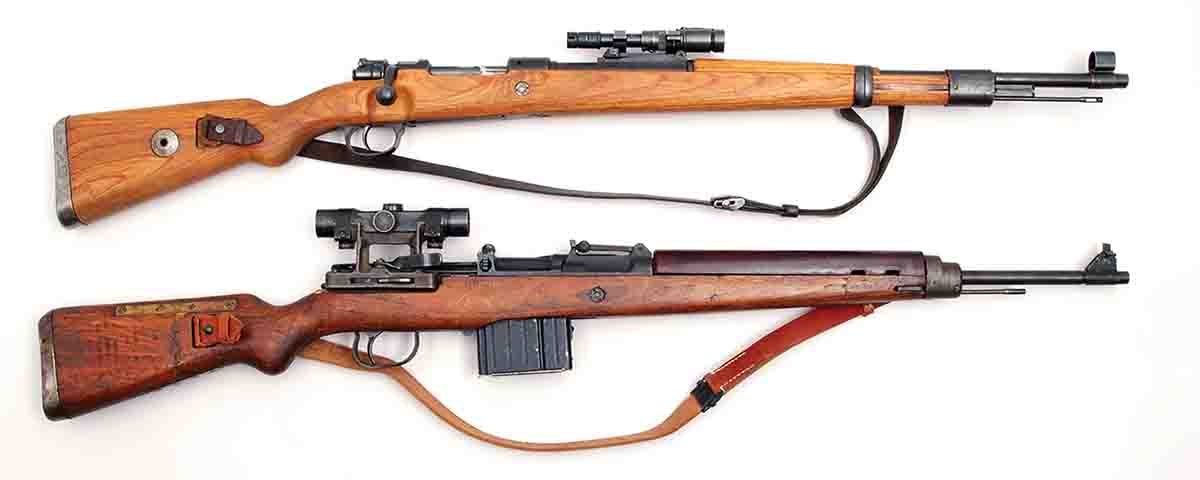
The top rifle is a K98k with a ZF41 1.5x scope. Below it is a K43 with a Z4 4x scope.
All German sniper rifles were chambered for 8x57mm, although there may have been some experimental versions chambered for the small 8x33mm cartridge of the Sturmgewehr MP44 or Stg44. As far as I can determine, no special “8x57mm sniper ammunition” was produced. In truth, there may not have been a need for it. Back in 2010 I traveled to Nebraska for an informal test of original World War II sniper rifles using military ammunition dated from the war years with former Hornady ballistician Dave Emery. We started shooting at 200 yards and increased distance 100 yards at a time. If a rifle would not group on a police-type silhouette target, it was dropped from the running. My K98k with a ZF41 1.5x scope shot well to 300 yards, and Dave’s K98k with a Z4 4x scope shot fine out to 500 yards.
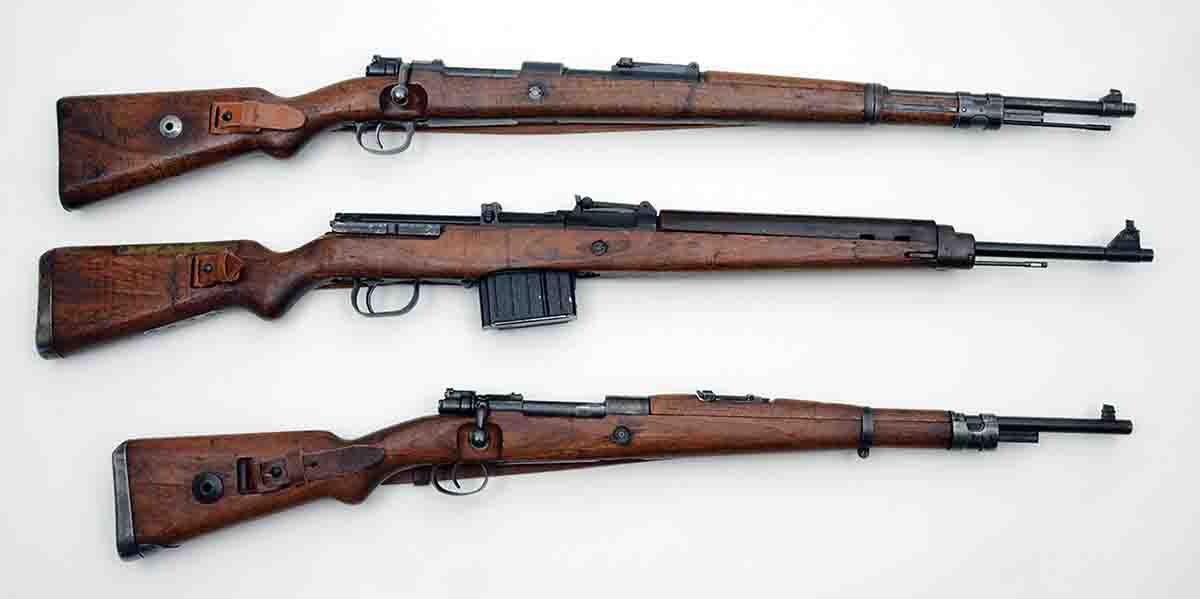
Three of the different 8x57mm rifles Germany issued to its front-line forces include (top to bottom): the K98k, K43 (also marked G43) and the G33-40.
What does it take to approximately equal World War II’s s.S. Patrone load? Upon acquiring my first K98k – a 1938 example made by Sauer & Sohn – reloading efforts included trying various bullet weights. That went pretty much nowhere in regard to getting bullets to land at point of aim. Germany used 300 meters as a basic combat zero. My range only goes to 300 yards, but with bullets from 150 to 170 grains, handloads were not zeroing in on rather generously sized steel plates. Then I shot Hornady 195-grain Spire Points. When driven fast enough to rival what German ordnance officers felt was a proper velocity for a 198-grain bullet, I began hitting the steel. Only bullets in the 195- to 200-grain range were considered here. It is interesting to note that available .323-inch target bullets of this weight are almost as plentiful as hunting bullets. For instance, there are Hornady 195-grain Spire Points, Nosler 200-grain Partitions and AccuBonds, and Speer 200-grain spitzers. Conversely, Nosler and Sierra now market 200-grain HPBTs, and Hornady has a 196-grain HPBT. Since buying my first K98k around the turn of the century, I’ve collectively fired thousands of these bullets, excepting the Nosler Partitions, without being able to determine that one is significantly superior to the others for their given purposes.
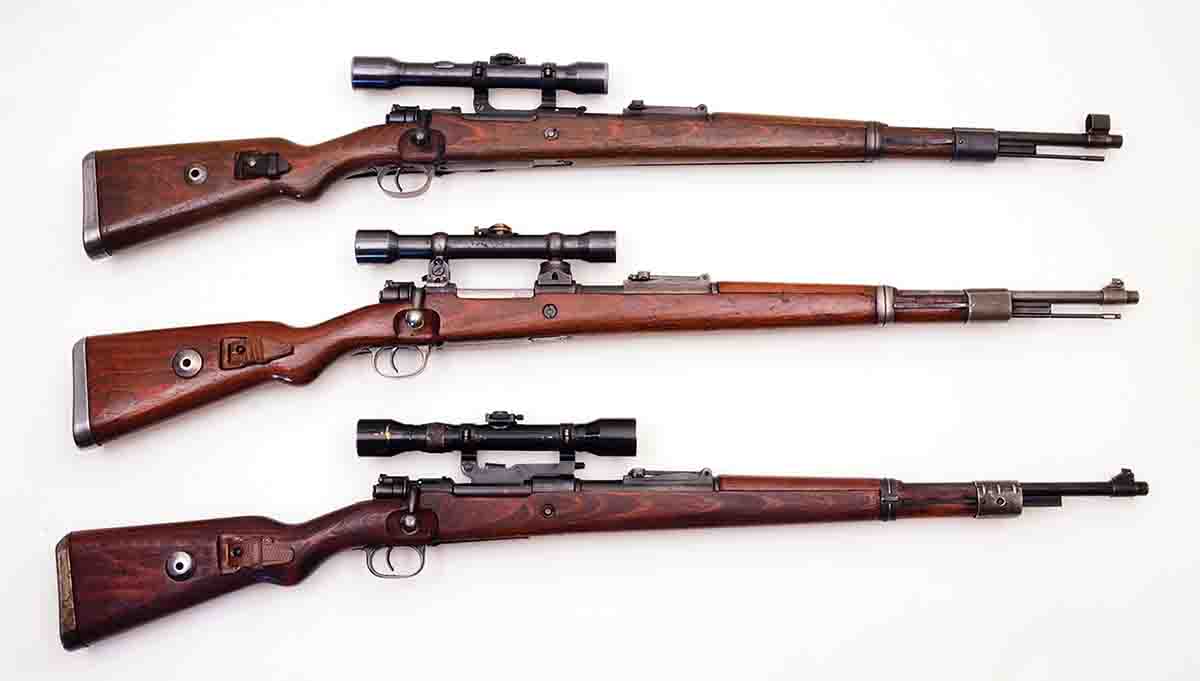
These sniper rifles are more or less original and include (top to bottom): a K98k with a Kahles 4x scope in short side rail mounts, a K98k with a Zeiss 4x scope in low turret mounts and a K98k with a Hensoldt 4x scope in long side rail mounts.
Upon taking up 8mm Mauser reloading, intuition suggested IMR-4350 would be the best propellant – wrong. It seems this old favorite is just a tad bit too slow burning to achieve 2,500 fps. Slightly faster burning powders got me nearer to the goal. Taking my different rifles into consideration, I found it easy to get K98ks, with their 23.6-inch barrels, to 2,400 fps, or to 2,300 fps from the 19.6-inch barrel of the G33/40. Getting the extra 100 fps needed for breaking 2,500 fps was more difficult. That required maximum loads of Varget, Vihtavuori N140, IMR-4895 or Reloder 15, so in viewing the accompanying load table, do not copy the loads directly. These loads are safe in my rifles but could be over maximum for yours. Please work up from below.
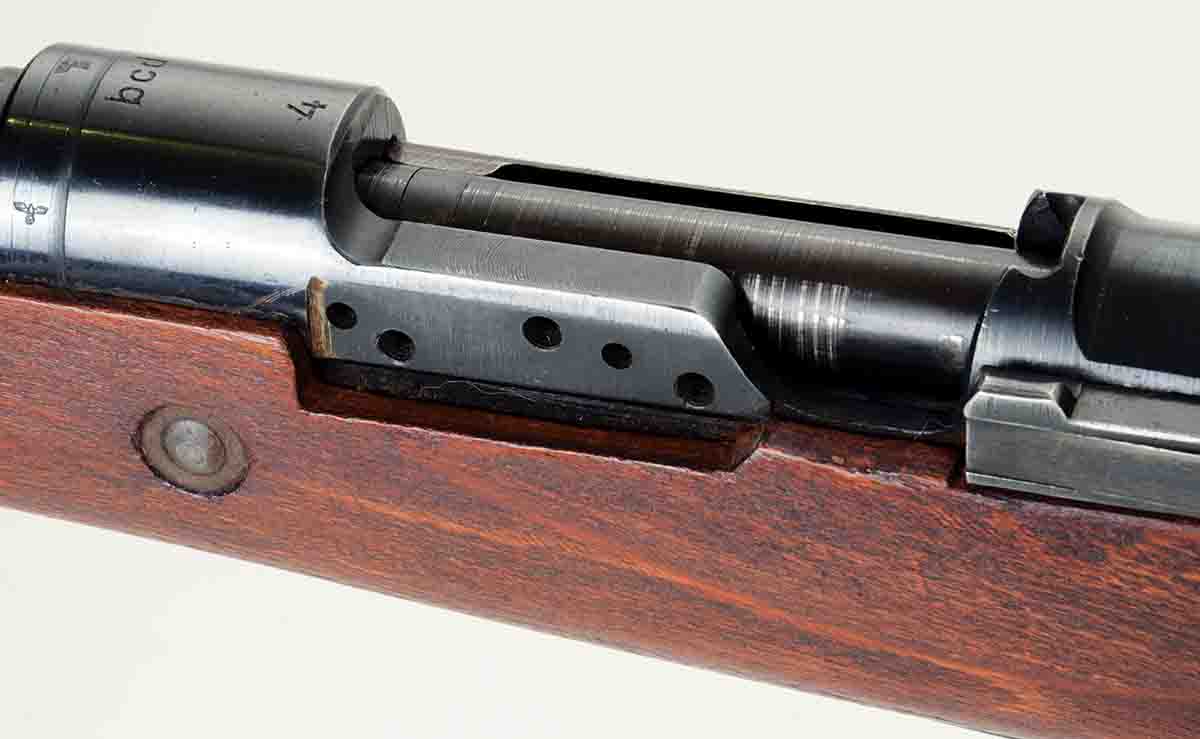
The only German-manufactured sniper rifles were marked “BCD4” and had an extra-thick left receiver rail.
Returning to the K43, the very first round shot from it was a Yugoslavian military surplus load. I just stepped outside my door to check if my new purchase actually fired. It surely did; ejecting the empty case a full 20 feet! Before shooting it again, I consulted the Internet and found that such violent behavior often resulted in parts breakage on late-war rifles. Also discovered was a business, Apfeltor Waffenbabrik (Apfeltor .com), selling new springs and gas plugs for G/K43s. Also sold was a solid plug that could turn it from an autoloader into a manually operated repeater. Since the K43 has all its numbers matching, that is what I have done with it, except for special occasions.
After firing the many thousands of rounds necessary for my book Shooting World War II Small Arms, I came to greatly appreciate the 8x57mm. I rate it as equal to the .30-06 in all respects. Looking back on my hunting career, a nice 8x57mm sporter would have made a fine elk and deer rifle.











